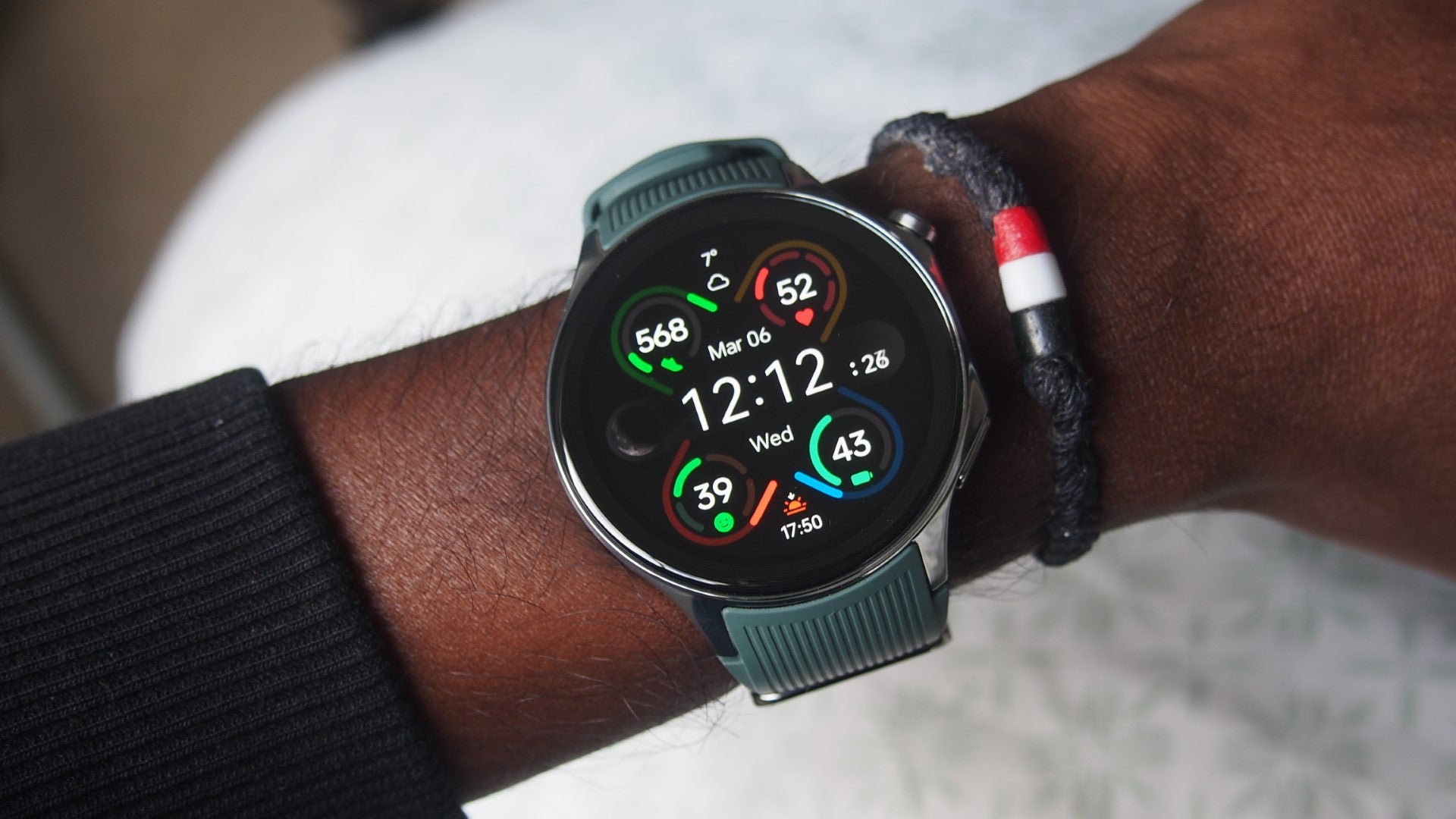Garmin Enduro Review
Best battery life going
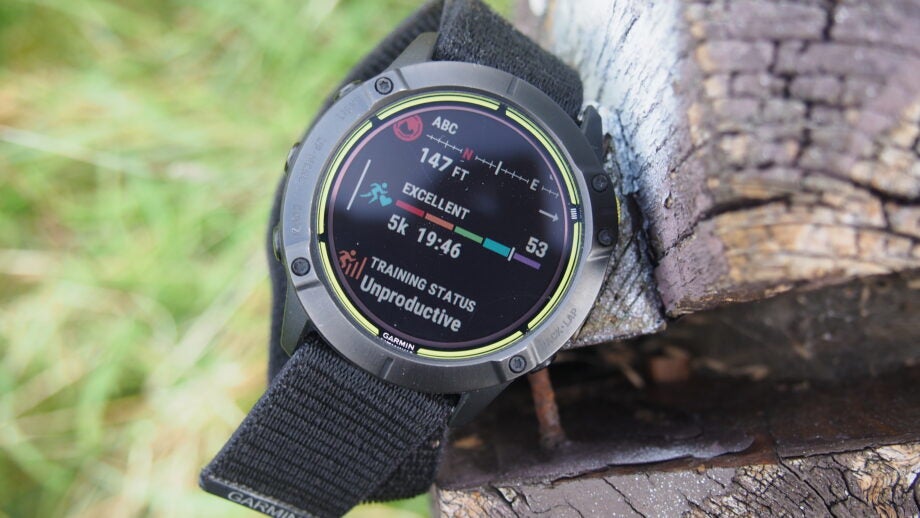

Verdict
The Garmin Enduro isn’t the best watch in Garmin’s extensive collection of wearables, but it is the one with arguably the biggest battery life. If you’re willing to spend big to charge on a less regular basis and you want a good mix of sports and smartwatch features, there’s still plenty to like about the Enduro.
Pros
- Big battery life
- Lighter titanium option
- Solid sports tracking
Cons
- Only breadcrumb navigation
- No music player
- It’s not cheap
Availability
- UKRRP: £699.99
- USARRP: $799.99
Key Features
- Battery lifeUp to 80 hours GPS battery life (with solar)
- DesignComes in stainless steel or titanium bezels
Introduction
The Garmin Enduro is the latest watch in Garmin’s ever-growing collection that’s made for endurance athletes featuring a battery life that can go the distance.
Using its Power Glass solar charging lens technology and power management features, the Enduro is capable of going for months and even potentially a year, all while still giving you access to big sports tracking and smartwatch features.
Like most Garmin watches, it serves up tracking modes aplenty and outdoor-centric features. Highlights include the ability to better track VO2 Max while trail running, robust navigation services and post work analytics designed to make sure you’re not overreaching.
At £699.99, the Enduro doesn’t come cheap, sitting in the same ballpark as expensive watches like the Garmin Fenix 6 and the Coros Vertix 2. The question is, does that high price get you one of the best sports watches in the business? We put it to the test to find out.
Design
- Transflective always-on display
- Weighs 61g (titanium) or 71g (stainless steel)
- 51mm case
- 26m removable straps
The Garmin Enduro certainly isn’t a small watch, with its 51mm polymer case measuring in at 14.9mm thick. This means it takes up similar wrist real estate to the Garmin Fenix 6X and the Coros Vertix 2.
Garmin offers it up with either titanium or stainless steel bezels, which does make a difference to the watch’s weight and impact how they feel to wear day-to-day. I’ve tried both titanium and stainless steel versions and the titanium is noticeably lighter. Though it does come at added expense, pushing the price up to £799.99 from the £699.99 you’ll pay for the stainless steel version.
The case bodies are matched up with a new ultrafit nylon strap that helps keep things light. The strap means you can still keep the watch on in the shower or when you’re in the water. I’ve found that while that strap is nice and comfortable, it is starting to show signs of wear at the clasp end of the strap after a few weeks hardcore use. Thankfully these are straps you can change and it uses springbar-style lugs to help you switch in something new.
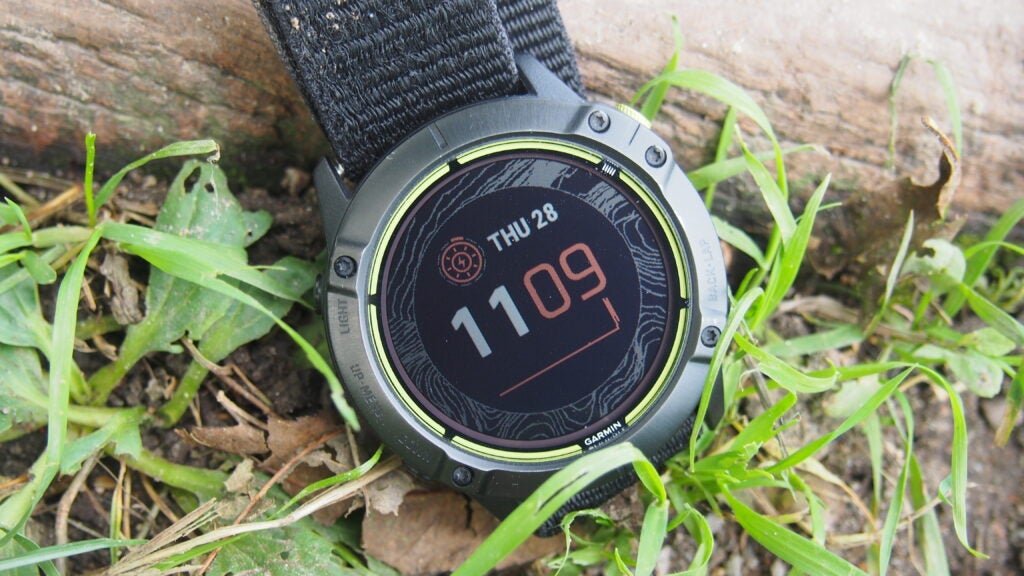
There’s the standard five physical button navigation you find on most Garmin wearables to help you get around the watch screens. But I found the top right buttons comes with a more textured finish. This marks it as the input you use to launch that sports tracking screen. If you’re coming from a smart watch be warned, you’re not getting a touchscreen here. If you want a Garmin with one of those, you’ll need to look at its Venu series. It’s a 1.4-inch, 280 x 280 resolution transflective display, which is a nice size to absorb stats on the move and offers strong visibility in bright outdoor light conditions. You’ve also got a backlight to come to your aid at night too.
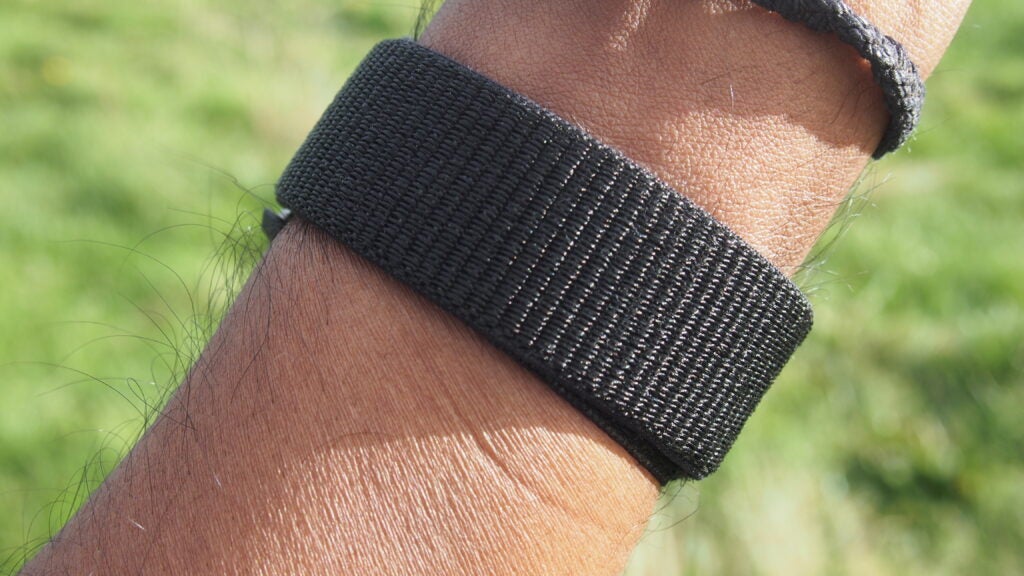
Like all Garmin watches, the Enduro is suitable to use in the water and does offer pool and open water swimming. The 10ATM water rating isn’t the highest protection you can find on a Garmin but does mean it’s fit to be submerged up to 100 metres depth. I’ve tested for indoors and outdoor swims and can confirm the Enduro holds up in the water.
Tracking and features
- Large collection of sports tracking modes
- Breadcrumb navigation
- Garmin Pay support
- Supports multiple satellite systems
- Trail VO2 Max data
The Enduro is geared for spending a lot of time outdoors and that’s reflected in the features it packs and the activities it can track.
Core tracking lies with running (including trail and ultra running modes), cycling, swimming and it does have a dedicated golf mode here too. It also offers tracking for the likes of hiking, mountain biking, rowing and kayaking with activity-specific metrics on offer. It does cover indoor activities too, so it will work with indoor cycling, surfing and rowing among other niche pursuits.
Runners, and particularly long distance runners, are going to be attracted to the Enduro. That’s because you’re getting a dedicated ultra running mode with rest timers taking into account stopping at aid stations during races. There’s now Trail VO2 Max estimates to take into better consideration of off-road terrain. Though I didn’t find estimates were hugely different from the road-based estimates during testing.
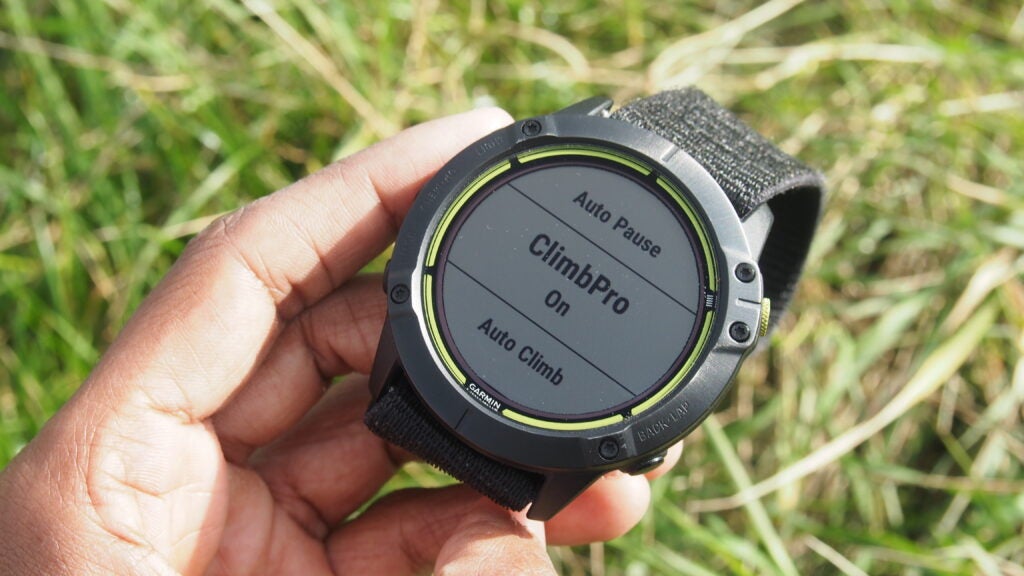
In terms of tracking for runs, it performs well from an accuracy point of view when compared to Garmin’s Fenix 6 Pro. I found the GPS locked on nice and quick and it was suitably accurate for road and off-road running on most of the core metrics. Garmin’s onboard heart rate monitor is good for steady paced runs, but like a lot of watches, grabbing a heart rate chest strap monitor and pairing that up with it will get you more reliable data for high intensity runs. It wasn’t the worst performer against a chest strap monitor, but if you want to make the most of the onboard heart rate based insights, grab a chest strap.
On top of the tracking you’re getting a wealth of additional data and insights. The Enduro can monitor your acclimation to heat and altitude, offer suggested workouts and features Garmin’s much improved recovery advisor. There’s training load focus and training effect insights here to better understand your level of training and whether you’re working out enough or too much.
Some of these features should definitely be regarded more as guidance, which is useful for anyone that’s not really got to grips with some of the more overwhelming aspects of using one of Garmin’s more feature-rich watches.
For cyclists, there’s useful extras like an improved version of Garmin’s Climbpro mode, which now adds better support for trails to help you plan for the ascents and descents on a route. The mountain biking dynamics adds new metrics to tell you more about the trails you’re tackling.
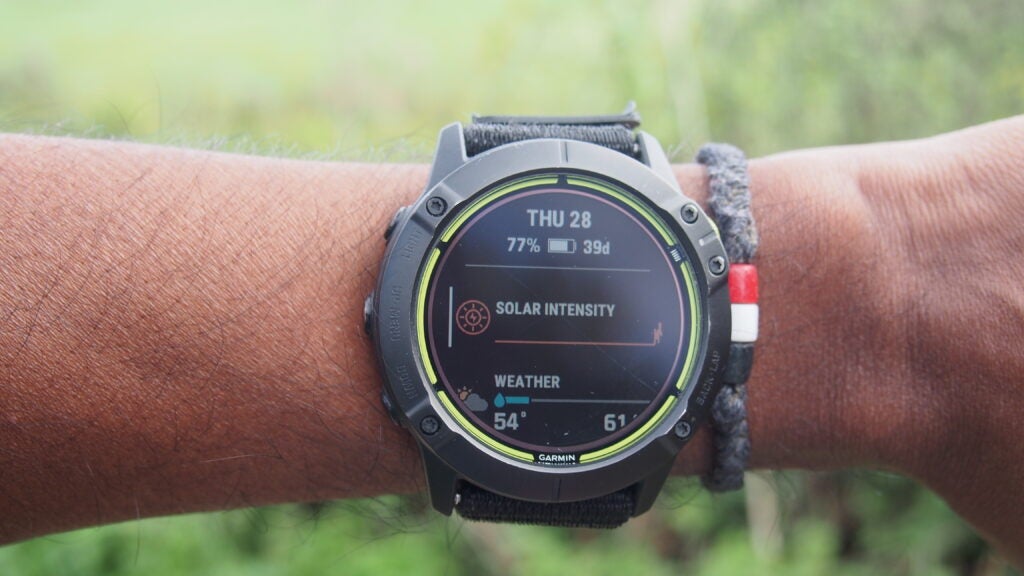
Like most of Garmin’s top end watches, the Enduro offers navigation features and the ability to upload routes to the watch. It doesn’t have the richer mapping support available on Garmin’s Fenix range, instead offering the more simpler breadcrumb navigation you’ll also find on cheaper Garmin watches. That breadcrumb navigation should be good enough for most, but it’s a shame the Enduro misses out on one of the best features available on Garmin’s watches.
Away from sports tracking, you’re getting features like daily activity tracking and sleep monitoring, which does tend to be a little heavy handed in overestimating sleep duration compared to what you get from Fitbit or Polar’s latest watches. Along with heart rate and stress monitoring, there’s a pulse ox sensor to monitor blood oxygen levels 24/7 or just during sleep but doing that will severely impact on battery life.
It’s good to see Garmin’s big safety features are in tow here too. There’s support for Livetrack and group Livetrack modes and there’s incident detection and assistance modes that work as long as you have your connected phone nearby.
All of Garmin’s watches work more like smartwatches and that’s no different here. This is a watch that works with Android and iOS devices, letting you view notifications, make payments via Garmin Pay and you do have full access to Garmin’s Connect IQ store to download native and third party apps, watch faces, data fields and widgets.
The only smartwatch feature that doesn’t make the cut is a music player. As a noticeable power draining feature, it’s not all that surprising its been cut, however. Notification support works well enough, as do the music controls and its smartwatch powers should be enough for most those not desperate to use loads of apps.
Battery life
- Up to 65 days in smartwatch mode (with solar)
- Up to 1 year in battery saver mode
- Up to 80 hours GPS battery life
- Power manager features
Battery life is where Garmin is aiming to make the Enduro stand out from the crowd. It doesn’t specify the capacity of the battery packed in here, but does talk some big numbers.
In general smartwatch mode you can get anything from 50-65 days. You can get that 65 days when you factor in the solar powers of the Enduro. You’ll need to also make sure the watch has been outside for 3 hours in 50,000 lux conditions to make sure you hit those big numbers however. In the UK, where the sky is often overcast that’s a pretty tall order.
When you put GPS tracking to use, the Enduro is capable of lasting 70-80 hours. There’s also a max GPS battery mode and expedition battery modes that will sample GPS data in longer intervals to boost battery life. The expedition mode could get you up to 95 days. There’s even a very basic watch mode that is capable of going a year. You just won’t be able to use many features.
I’ve managed to use the Enduro for well over a month with regular GPS tracking, notifications enabled, continuous heart rate monitoring, daily activity tracking and sleep monitoring. Using the GPS for long periods including a 3 hour 20 minute marathon didn’t dent the battery in a really undesirable way. That’s with the watch used in full GPS mode and paired up with Garmin’s HRM-Pro chest strap monitor.
It’s also without putting Garmin’s power manager features in use, which lets you disable features you don’t regularly use and might be demanding a lot of power. It really does have impressive staying power whether you’re using it intensively or more sparing with tracking.
Latest deals
Should you buy it?
You want an outdoor watch with big battery: Garmin talks big numbers for the Enduro and based on my time, it really does deliver on the front
You want the most feature-rich Garmin watch: For the price, you’d expect the Enduro to give you the best that Garmin has to offer. Unfortunately, it does miss out on some big features like full mapping.
Final Thoughts
The Garmin Enduro isn’t the best Garmin watch you can buy, but it’s certainly the best when it comes to battery life. Pick it up in titanium and you get a big watch that feels light to wear too, though that comes at quite a high price. Garmin’s Fenix 6 Pro still feels like the smarter choice here, but if you really do want that huge battery and those great core Garmin tracking, metrics and training insights, you will get those here on the Enduro.
How we test
We thoroughly test every smartwatch we review. We use industry standard testing to compare features properly and we use the watch as our main device over the review period. We’ll always tell you what we find and we never, ever, accept money to review a product.
Worn as our main smartwatch during the testing period
Heart rate data compared against dedicated heart rate devices
Side-by-side GPS comparison with our best scoring smartwatches
FAQs
Yes, there is full support for both platforms
There is no music player here



